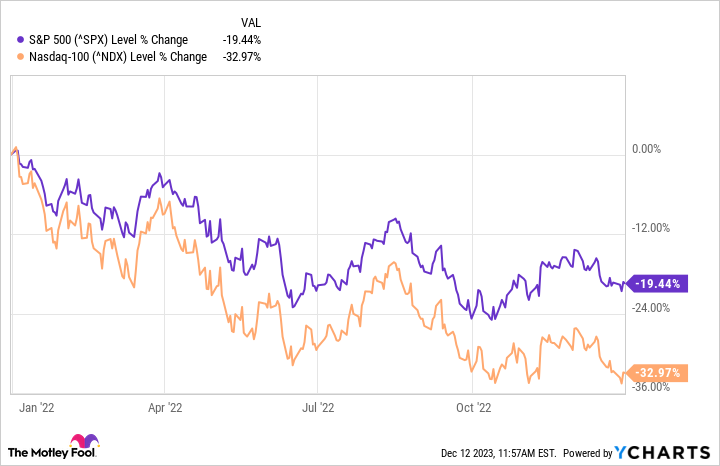Reflecting on the stock market in 2023, I can honestly say many major indexes and companies performed better than expected. All three major indexes (S&P 500, Dow Jones Industrial Average, and Nasdaq Composite) are positive for the year, and unless something drastic happens, they should finish the year that way.
One of the bigger winners of 2023 has been the Invesco QQQ ETF (QQQ 0.48%), which mirrors the Nasdaq-100 index. The Nasdaq-100 tracks the 100 largest nonfinancial stocks trading on the Nasdaq stock exchange. Its popularity has made it the second-most traded ETF in the U.S., based on daily volume traded.
Surges from megacap tech stocks can be credited for much of the Invesco QQQ ETF’s success in 2023 and should continue to drive its growth. That said, regardless of how lucrative the Invesco QQQ ETF has been, there are two ETFs I appreciate more going into 2024: the Vanguard S&P 500 ETF (VOO -0.15%) and Vanguard Growth ETF (VUG 0.27%).
A more diversified approach with the S&P 500
The Invesco QQQ ETF contains companies from all major sectors, excluding financial, but it’s mostly made up of technology companies. The technology sector is 57.1% of the ETF, far above the second-place consumer discretionary sector at 18.7%. That’s much more concentrated than the Vanguard S&P 500 ETF.
The S&P 500 tracks the 500 largest public U.S. companies, so the Vanguard S&P 500 ETF contains roughly five times as many companies as the Invesco QQQ ETF. This allows the Vanguard S&P 500 ETF to cover a lot more ground with a single investment.
Here are the top five sectors in each ETF and how much of them they make up:
| Invesco QQQ ETF | Vanguard S&P 500 ETF |
|---|---|
| Technology: 57.10% | Information technology: 28.10% |
| Consumer discretionary: 18.73% | Healthcare: 13.20% |
| Healthcare: 7.12% | Financials: 12.70% |
| Telecommunications: 5.48% | Consumer discretionary: 10.60% |
| Industrials: 4.87% | Communication services: 8.70% |
Data source: Invesco QQQ ETF and Vanguard S&P 500 ETF fund pages. Table by author.
The concentration of technology companies has benefited the Invesco QQQ ETF because of the growth of the technology sector in general, but there’s no ensure that it will continue that way. The sector isn’t invincible and has had its fair share of struggles.
The Nasdaq-100 finished 2022 down close to 33%, while the S&P 500 was “only” down by 19%. The Vanguard S&P 500 ETF’s diversification helps reduce sector-specific risks, offering more stability during downturns in any specific sector, including technology.
The Vanguard Growth ETF is a good mix of the two
The Vanguard Growth ETF focuses on large-cap growth stocks. It can be the sweet blend between the diversification of the Vanguard S&P 500 ETF and the growth-centric nature of many of the Invesco QQQ ETF’s holdings. The Vanguard Growth ETF hasn’t had the year the Invesco QQQ ETF has, but it’s up over 42% in 2023 — more than double the S&P 500’s returns.
The Vanguard Growth ETF contains 221 companies, and many of its top holdings overlap the Vanguard S&P 500 ETF and Invesco QQQ ETF’s holdings. The only companies in the Vanguard Growth ETF’s top 10 holdings that aren’t in the Invesco QQQ ETF’s top 10 are Eli Lilly and Visa.
Although the Vanguard Growth ETF is still tech-concentrated (Apple and Microsoft make up over 25% of it), the number of holdings allows for a broader achieve. This wider coverage provides a more balanced investment approach, satisfying investors who want the stability of large-cap stocks while being more aggressive with exposure to growth opportunities.
It doesn’t have to be one or the other
Each ETF has its unique value proposition, so different parts may appeal to different investors. It’s not a this-or-that situation where you have to pick one, but if you’re going to invest in multiple ETFs, be mindful of the overlap of companies. This is extra important, considering most market-cap-weighted ETFs will contain many of the same megacap companies.
A portfolio with hundreds of companies can have its advantages, but some of those advantages go away if the vast majority is concentrated in a few companies. By carefully balancing your investments between ETFs (not just these three, but in general), you can capitalize on each one’s unique strength while mitigating risks.
Stefon Walters has positions in Apple, Microsoft, and Vanguard S&P 500 ETF. The Motley Fool has positions in and recommends Apple, Microsoft, Vanguard Index Funds-Vanguard Growth ETF, Vanguard S&P 500 ETF, and Visa. The Motley Fool has a disclosure policy.




